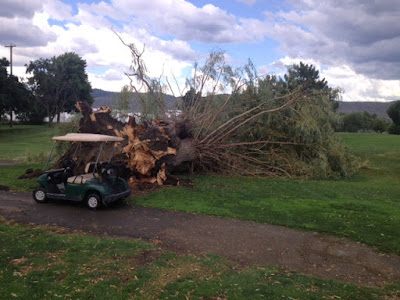 |
| A frosty fall morning |
Fall fertility of the turfgrass is very important. Helping the plant produce and store carbohydrates for the winter will increase its chances of survival. Both timing and type of fertilizer are very important in ensuring the plant's health as it heads into winter. If we apply too early the plant will use up too many carbs, and if we are too late the plant will not be metabolizing enough produce carbs through photosynthesis. Fertilizers with high potassium are desirable as this is the nutrient that promotes carbohydrate production and storage, as well as silica, which has recently been shown to provide strength in the cells walls of the plant, aiding it in its winter survival.
The next step in putting the course to bed for the winter is when we blow out our irrigation system; this usually takes place in late October before temperatures dip down below zero. This is a laborious task, that requires a commercial sized air compressor and alot of driving around to turn on irrigation heads and quick coupler valves. The whole process usually takes two people about two days to complete.
 |
| The mist of Irrigation Blow out |
Applying fungicide to prevent the formation of snow mold pathogens on the turf is the most expensive treatment we apply on the course all year, but for good reason. Without these chemicals, our turf would be mostly desiccated by disease and we would not be able to open the course until June or later, as we try and re-establish the turf. We spray our greens, tees and fairways in early to mid November before the snow begins to fall.
 |
| Fungicide Application |
While we are completing all of these tasks we still have a variety of other jobs to do on the course:
- Taking in all the course accessories and markers, rakes, etc
- Taking in all the drinking fountains and pond fountains
- Covering memorial benches with poly wrap
- Blowing, sweeping and mulching leaves
- More blowing, sweeping and mulching leaves
When the golf course closes for the winter our job is far from over.. Putting the course to bed properly is one of the most important things we do all year, it helps to ensure we get started on the right foot next spring.
 |
| Winter Preparation |
Once the course is finally put to bed for the winter we can begin our winter turf maintenance, yes we keep busy right through the winter! If you are interested in what we do for the rest of the winter see my previous post: What-do-you-do-in-the-winter?























